Everyone knows about the ongoing classic car show in Cuba. Cars from the ‘50s and ‘60s being used as everyday drivers – by almost everyone.
It’s not because the Cubans appreciate classic cars. It’s because old cars are what they can afford. They keep them running with hand tools and whatever’s handy. Improvise, make it work.
Coming soon, to a town near you – and for similar reasons.
A small but growing portion of the driving public is opting out of the new – and “modern” – car market, because new cars have reached an event horizon of cost-too-much/too-much-hassle/too-much-nannying.
Most people have to finance them – for twice or longer the duration of what used to be the traditional car loan (about three or four years) and that ongoing, seemingly interminable expense is compounded by having to pay someone else to fix them – even minor things – because most people can’t fix new/late-model cars themselves. They are too complicated, require specialized tools – including diagnostic equipment – they can’t afford or justify buying.
Cost to fix is going to be an obvious problem in the next few years, as the latest crop of cars with direct-injected, turbocharged engines and transmissions with eight, nine and ten speeds begin rack up miles and things begin to need fixing.
By going older, you can avoid all of this. Cars made before the early 1980s are machines rather than iPhones on wheels. They are mechanical things, not electronic things. The engine is an engine. There it is, simple. If you understand the basics – fuel, air, spark – you can understand its workings and do the fixings. No codes to “pull.” No IV diagnostic hook-up to a $10,000 manufacturer proprietary mainframe that only the dealer has.
No ABS, just brakes. So no expensive ABS pump.
A $20 sealed beam headlight vs. a $300 plastic headlight “assembly.” Sure, the “assembly” produces superior luminosity. And a suite at Trump Towers is nicer than a room at the Holiday Inn.
But when cost is an object… .
Steel wheels that can take potholes without bending and which can be replaced if you ever need to for $10 or so at a parts yard.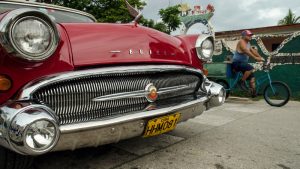
A $35 mechanical fuel pump hanging off the side of the engine that you can get to – vs. a $150 electric pump inside the gas tank.
And – magnificently – no air bags. No chance that your face will be shredded by shrapnel and no worries about the car being a total loss after a deer strike or minor fender bender – otherwise easily and not-too-expensively fixable – on account of thousands of dollars’ worth of “deployed” air bags to replace.
Many of the key components in older cars are not specific to that particular car. The manufacturers – the car companies – used to use the same engines/transmissions (and many other parts) in numerous models, often over long spans of time. Obvious examples of this include the GM “small block” V8 that was basically the same from 1955 through the early ’90s and the Rochester four barrel carburetor and the HEI distributor – all of which were used in millions of different GM models. They easily interchanged, even in cars that were of various vintages. In a modern car, most of the major parts are designed for that specific car – and for the specific combination of options it has. You have to use the same parts – or the computer will have a conniption fit.
And unlike electronic things – which you throw away once they stop working and replace with new parts – mechanical things can often be rebuilt to as-new for next-to-nothing. Example: Cast iron engines which can be bored and honed multiple times, cheaply – vs. aluminum engines that have to be sleeved, expensively. And usually, can’t be re-sleeved much because there’s not enough material in the block to allow for hogging out the cylinder bores.
Most of the old car is fixable by you. And it can be crutched, Band-Aided, gimped, cajoled. Fixed by the side of the road. Modern electronically controlled cars either work . . . or not. They sometimes just stop working. Rarely are they by-the-roadside fixable.
Lower cost to insure – insurance being a function of replacement cost.
Really inexpensive to buy, too.
Mind, we are not talking about the collectibles here. Muscle cars, sexy coupes, the well-known cars – the desirable cars (as far as being collectible). We’re talking transportation. The sedans and wagons.
The homely ones.
Most especially, the economy models. Cars like the Ford Maverick and Chevy Nova and Dodge Dart.
The Pacer and Gremlin. They could be had with V8s, you know.
And yes, even Chevettes and Vegas and Pintos, too. These latter were rear-wheel-drive, a simpler and more durable layout that today is exclusively the layout of expensive performance and luxury-sport cars. There was room to work under the hood of a Chevette or Pinto because its engine was mounted front-to-back and not snugged up against the firewall, making access to one side of it difficult if not impossible with the engine still in the car.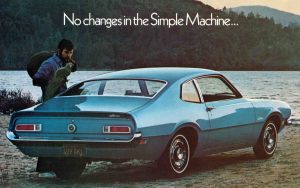
Pulling the transmission – bolted behind the engine – was (and still is) incredibly simple, a matter of removing the 6-8 bolts that secure the transmission case to the rear of the engine and lowering the thing using a floor jack and a piece of 2×4. The rear axle (made of rugged cast iron) in these old-school econo-cars rarely requires anything in the way of maintenance – beyond occasionally changing the gear oil and maybe, at some point, a bearing or race. Compare with the cost of a modern car’s FWD transaxle, CV joints and independent rear suspension.
And before you laugh, realize: Any of those cars can be easily updated with a few key parts that can make them just as reliable and everyday drivable as anything new, but without the seven years of debt servitude, the nanny-state technology (including the lethal air bag technology) and fixable by almost anyone who can turn a screwdriver. 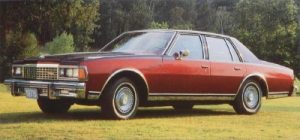
The appeal is, well, obvious.
Which is why now would be a good time time to get in on the action before the inherently limited supply of good candidates disappears. There will also likely be business opportunities for people who can fix these older cars up – maybe updating them in a few key areas, such as adding a simple, stand-alone throttle body fuel injection system in place of a finicky carburetor – and then selling them to people who’d much rather spend say $8,000 on a really nice/mechanically refurbished full-sized ’78 Chevy Caprice with a V8 engine and room for six than $18,000 for a new FWD compact with a turbocharged four and a ten-speed transmission that will cost $5,000 to replace when it chucks parts all over the road.
Viva Fidel!
If you like what you’ve found here, please consider supporting EPautos.
We depend on you to keep the wheels turning!
Our donate button is here.
If you prefer not to use PayPal, our mailing address is:
EPautos
721 Hummingbird Lane SE
Copper Hill, VA 24079
PS: EPautos stickers are free to those who send in $20 or more to support the site. Also, the eBook – free! – is available. Click here. Just enter you email in the box on the top of the main page and we’ll email you a copy instantly!




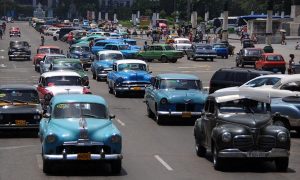
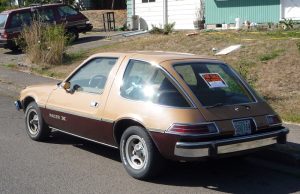








Many/most of the antiques in Cuba are powered by old Soviet diesel engines:
https://www.nbcnews.com/news/latino/voices-cuba-s-vintage-cars-are-cool-not-their-exhaust-n603951
The problem with this plan is that the ICE will get harder and harder to find, as will fuel (although converting to natural gas should be doable, and installing a compressor and storage tank in your home is possible but probably expensive), assuming we get to an inflection point where electrics outnumber gassers to the point filling stations are able to switch out their pumps for chargers and be profitable.
While I was back east this summer I visited a few Sheetz gas stations. I didn’t think to see if they had charging stations, but I did see they now had seating and free wifi so you could eat your calorie laden treats in the store instead of spilling them all over the passenger seat. I wonder if they’re getting ready for the day when everyone just stops every 20 minutes for a fillup?
Cripes, the electric car fanboys are living in a dream world. ICE and fuel are not going to get harder to find any time soon, certainly not within my lifetime. Even if electric cars get out of the government-forced boondoggle stage and become economically viable and practical on their own merits there is a huge installed base of vehicles that is not going anywhere any time soon and many, many more uses for internal combustion engines than just automobiles. I don’t think the people in Cuba have anything to worry about in terms of keeping their Soviet diesels running for many years to come.
The Chrysler 225 six is my favorite engine, everything accessible for maintenance purposes, rugged and reliable. Problem was every car I ever had with it rusted away long before the engine came close to wearing out ?.
Anyone remember steam cars? There are some around for 35k- and they can run on wood and water. Usually they use liquid fuel of your choice though
Note, the gang bangers have been on this kick for some time now. 65 LTDs and 70s Impalas, jacked to the sky with 22″ Ree-ums but, taking the simple path for ride ease.
It’s not my style but, I have to give them credit for salvaging what would otherwise go to the crusher.
5 grand and some sweat equity might be my next challenge. I had a 76 Delta 88 some time back…maybe it’s time for another.
Eric, great piece.
A recent video of a fellow in Havana talking and riding with someone that had a 58 Chevy. Lifting the hood was interesting: Something like an old Ford 223 six had been installed. The “owner” said this was the only way you could keep these cars going.
So…next time you see some wonderful 53 Desoto down there, it may have a 239 Ford Flathead with a cast iron Powerglide adapted to it.
Al, that old 223 was once the favorite engine for dirt track racers in the Carolinas. You could bore them .90 over and still have good cylinder walls and there was a carb/intake setup made in Charlotte for those engines called a Predator. They worked fine for dirt tracking.
My ’60 Ford shortbed had a 292, which I swapped out for a 223 from a junkyard for $75. Good engine, that 223.
The interaction between social classes
I am convinced that societies such as the Indians which live without government enjoy in their general mass an infinitely greater degree of happiness than those who live under the European governments.
Among the Indians, public opinion is in the place of law, & restrains morals as powerfully as laws ever did anywhere.
Among the Europeans, under pretense of governing they have divided their nations into two classes, wolves & sheep. I do not exaggerate. This is a true picture of Europe.
Cherish therefore the spirit of our people, and keep alive their attention. Do not be too severe upon their errors, but reclaim them by enlightening them. If once they become inattentive to the public affairs, you & I, & Congress & Assemblies, judges & governors shall all become wolves.
It seems to be the law of our general nature, in spite of individual exceptions; and experience declares that man is the only animal which devours his own kind, for I can apply no milder term to the governments of Europe, and to the general prey of the rich on the poor.
— Thomas Jefferson, Letter to Edward Carrington – Jefferson died in 1826 with immense amounts of debt.
OK car guys, enough politics, let’s talk cars again.
Here’s my dilemma, wife and I “work camp” in our diesel pusher motorhome — we work at national parks in return for a full-hookup camping spot.
I’m looking for a “toad” (that’s a vehicle towed behind a MH) that has cargo space and roof space to haul stuff.
Toads work best when equipped a with straight drive transmission and towed when shifted into neutral.
Please suggest an older vehicle that I can easily and cheaply maintain; may a 60’s, 70’s or 80’s American made station wagon?
TIA
Hi Clay,
I think a great choice for this would be an ’80s-era RWD Subaru (e.g., a Brat). These are tough little suckers, easy to maintain and (if it’s a Brat) can be used to carry/haul a surprising amount of stuff. Also, manual transmission.
GM wagons from the ’80s are solid vehicles, but they are almost all FWD and automatic only. If you can abide that, they are good choices, too.
If you can handle something larger, a Volvo wagon from the same era (RWD) is also a good choice. Some came with manuals, too – but they are hard to find.
If you can handle a full-size car, I am a big fan of GM’s “shamu” Caprice sedan/wagon from the ’90s. These have the excellent small block V8/four-speed automatic and are tough, rugged, hugely roomy cars that are easy to maintain.
Will try to think up some other options!
The thing about a Subaru is you’ll barely know it’s there. A friend worked at a machine shop in the 70’s and all he did was build lifts that hold either the front or rear tires of a vehicle drug behind a motorhome.
A Subaru was pretty common back then. I don’t recall anyone dragging a full size vehicle although I’m sure some of them did.
A local two way radio had a fleet of the station wagons they used to haul equipment to the top of mesa’s out in this country. They always have very steep sides and those Subaru’s just ate it up and kept coming back for more. First time I rode in one I was amazed at the slope and slippery rock they’d leave behind them. I took our baby Nissan 4WD(say it loosely, nobody, including Nissan, ever made LSD’s for them so it was actually 2 axle drive)up one of those trails and it took 2 tries before I could scrabble around a switch back. The next week I bought new wheels and 30.5X9.50 15’s for it and relegated those Goodyear Wranglers to trailers.
The BRAT and the Subaru wagon of the same era were probably the same vehicle. One neighbor had a BRAT another had the wagon. Both were nearly identical except for the back half body work.
I think you mean a 4wd Subaru – Brats (Bi-Drive-Recreational-All-Terrain) were 4wd; rather than engaging front wheel in 4wd mode the rear wheels were enabled. Front wheels had power always.
An excellent choice! We have an 85 w/4wd, locking center differential (in low range only) – it is THE BEST snow car, until the skid plates begin to plow..
“Left 1 2 3 4 5 6 7 8 9 10 Right”
That false paradigm you mentioned that puts Mao on the left and Hitler on the right is worth repeating. Everything in the middle would still have to be totalitarian. Americans are being misled into bickering over minor points of totalitarian socialism.
Very true, Ed… well said. There are differences between, say, a national socialist and a soviet communist – the former bases his totalitarian socialism on race and nation, the latter on being a member of the proletariat – but in the end both are . . . totalitarian socialism.
eric, I can’t even get to the socialism part of it before I’ve mentally injected “authoritarian” in there. If you can term anything as totalitarian you can bet a great bigun ol dose of “authoritarian” was in the play before “totalitarian” was an accurate descriptor.
I still deal with baby boomers who’ll argue about taxes not be collected at the end of a gun barrel. Not too many around here though that are landowners who don’t feel the sting of the blast when taxes are mentioned. Such a disconnect between city and country folk. I suppose it was always so.
I recall going to college and running head on into city people. We could barely communicate. City boys(and girls) would comment “what is that you said?”. The reply might be something like “I said it was a binder”. Reply “like a notebook, like a ring binder?”. No, like an International Harvester. “A what?”.
The coming advent of ubiquitous 3D printing technology has the potential to keep cars running forever. Plastic trim pieces can be scanned in and “printed” (made) and then installed by a mechanic or a shop. I am hopeful that as time goes on, more previously obsolete parts will become available to people who drive older cars. I am not sure that I want to drive a 1977 Chevrolet Caprice, but I am more than happy with my early 2000’s cars. They have the right blend of ride, NVH, power and handling for me. They aren’t easy, but not impossible to work on. There are some definite downsides, but overall, you can see around outside and they don’t broadcast their locations and “connected” I look forward to driving them until I am no longer able to do so.
To make cosmetically acceptable parts takes a lot of hand work after the rapid prototyping process. Of course the part is generally functional right out of the FDM machine. Some changes also need to be designed in for the process.
What will really be key is the ability to make metal parts via additive manufacturing at home.
I’m with you 100% on that time span of cars. Most 70’s & 80’s cars drive like garbage however the late 90’s to about 2006 is the real sweet spot of great driving cars with the amenities I want yet still DIYable. I’m a big fan of the e46 and e39 era BMW’s, cheap enough parts, tons of them in yards, parts interchangeability (within series), a full diagnostics suite can be had for $40 and read through a cheap laptop and all the problems are pretty simple DIY projects.
Right on. My cars are a 2005 Acura MDX (epxnsive parts though), 2003 Lexus ES300 and a 2007 Ford Mustang. I have been afraid of BMWs. What was the last year they had a dipsick for the transmission oil? The engine oil?
You say parts are cheap? Hmmm.
I would be interested in an X5. I might get rid of the MDX if its a good bet. Is that a go or a no go?
Those ES’s are nice, a lady friend had one once.
I’m pretty sure the dipstick left after the e46 and e39. Why they eliminated it I’ll never know. Parts are cheap enough, not cheeeap (if you will) but you get quality unlike the bs at autozone and they are easy to work on with a basic metric tool kit.
I have heard good and bad about the X5, I would buy one IF I could find one with maintenance history.
Except the Cuban nomenclature is not anti car snobs, unlike in the USSA. Technically right on. Culturally, the Cubanos are much better off.
I’ve found the biggest single problem is getting a title for an older car to be able to use it on the street. By design I think. 30 years ago in California, I took in a title for a 68 Karmann Ghia signed by the last RO, and a stack of 9 bills of sale in proper legal form, and walked out with plates and title. Last week I bought a 93 Chevy K1500 diesel, but the kid had signed the title, so according to the state, it can’t be transferred. That’s the kind of crap were up against.
Nomenklatura. ..
If you rank nations on the left wing to right wing scale, 1 to 10, Cuba is a certainly a 1, being the most confiscatory imaginable.
But America today is either a 2 or a 3 itself. Nearly anything an American does must serve the state. Even in the most remote area, the American is closely watched and never free. Always the hands are in his pockets and the boots are on his neck.
China might be theoretically a 1 like Cuba, but in actuality, areas like the South East are more like a 5 or 6. There is quite a bit of economic freedom. The further one lives from the ruling class, the better it gets.
American might have a lot of high sounding ideals written on paper. And the state may fund all kinds of institutions that claim to provide freedom. But it is all a pyramid of lies, not unlike what you see in North Korea. Where it is claimed everyone supports the tyrannical system, but the reality is there is no other real choice.
America is becoming as left wing authoritarian as you can get.
Left 1 2 3 4 5 6 7 8 9 10 Right
What is left wing.
In the American sense, left and right wing mainly differ in the attitude towards redistribution of wealth. The left is strongly in favor of it, claiming that the proletariat (work force) is opressed by the burgeoise, the 1%. The power of the state is seized by the people to redistribute the wealth among all citizens, so that everybody might live a comfortable life.
Communism (1) the left utmost ideology wants everybody to have an equal amount of income, with no discrepancy whatsoever between the wealth of the individuals. This heavily weighs on personal liberty and the american dream, which is why most Americans are against it.
If you let the markets do their thing, (10) there will be a massive middle class that would more or less be making the same. It would be a pretty decent bell curve.
The left wing communist system really makes everyone get paid the same. It ends with nearly all being in destitute poverty with the super elite at the top living like kings. This is the most comical part of it all. The typical commie activist is a college “educated” yuppie that has never done anything of value and has no skills. In a true communist system they would go to the gulag for failing to produce value for the state.
This is why Americans are against communism, the history of America being a right wing unregulated 10 free market is a large part of why America was originally so successful in the first place.
A rational man can’t possibly side with the left because they can’t even side with themselves.
The left say they despise the 1% and yet not one of them has stopped buying shit from Amazon.com. They’ve even let their 1% overlord invade their homes with Echo and provide the very food they eat. You’ll never meet an honest lefty, none of them has any problem with this unprecedented power grab by the super rich powerful elite. The left blindly support the 1% and agree to all kinds of impoverishing imbecilities such as cap and trade schemes for CO2.
Socialism leads into Communism which leads to power of the “collective”
Right wing ideas like capitalism lead to power of the individual.
Democrats are about a 3, they are highly confiscatory. Though most of the wealth is not redistributed, it is used for purposes decided on by the state itself. What is worst about them is they accept money from international sources to their own nations detriment. They are okay with their own country completely collapsing and being ruled by foreigners and outside polities.
Republicans are about a 2. More confiscatory than the democrats. They build massive militaries. They fund and expand a worldwide police and military. They work for international masters to their own citizens detriment. They are okay with breaking lots of inidividual eggs to create their vision of a national and international omelette.
Right wing philosophies demand that you work hard for yourself, left wing philosophies demands at gunpoint that you work for your government. Left wing leaders promise to help the “collective”, but it just never works because it was never “true communism”
Europeans mistakenly call fascism a right wing philosophy. But fascism is not right wing based on the United States political spectrum. In Europe, the conservative right, as America knows it doesn’t exist.
Let’s consider a scale from 1 to 10.
1 is super left wing. Strict Communist Socialists.
8 is Libertarians. Small government, do what you want, leave others alone. 9 is Anarcho Captialists. 10 is absolute anarchy, everybody for themselves, no rules, no masters.
In the US the whole spectrum exists, but the country leans right. Most people are between 3 and 8. Individual rights, freedom to take risks, free to build, and free to keep.
In Europe most people are between a 1 and 5. Everywhere is socialistic in nature. All nations have big government from cradle to grave. Government solutions and government direction. Most nations have a state church and royalty. Even the church and religion is part of their system. No individual religious beliefs to speak of.
Fascism is about a 3. So, it’s to the “right” of Communism, and many Europeans consider it “right wing.” However, on the American spectrum it’s a left wing ideology being 3 on a scale of 10.
Anarchy—complete lack of government—not libertarianism is the only perfect 10. The problem with it is people today have a lot more power in groups than they used to. Its hard for anarchy to long survive. In any power vacuum, the collectivists quickly move in and create some form of left wing system serving rule of law or other.
Total laissez-faire capitalism could be considered a 9, libertarianism and8; but these are minor details.
The beauty of the 1 to 10 model is it correctly places ALL systems with oppressive boot-on-neck experience of the people on far left—communism, socialism, fascism, islamofascism, monarchy, plutocracy, oligarchy, all authoritarian statism goes there.
And places those systems without that experience on the right. That’s the measure that matters: the freedom of the people. Not the arcane economic and political “differences” highlighted by college professors. Not the economic historians trying to place every system into some grand context that holds true the entire span of human history.
The left side of the political spectrum is for big government control, with the far left being classics like communism. The right is in favor of less government control, with the extreme far right being no government whatsoever.
Fascism is left-wing because it follows very closely to socialism. So when a liberal claims that extreme left is communism and extreme right is fascism they are completely wrong and should be corrected. These are both leftist ideals. A far right extremist would someone that cuts down stop signs in his neighborhood because he sees it is an infringement by big government.
Right Wing – less government & more individual freedom
Left wing – more government & less individual freedom
Once the modern ruling class steals the dream of owning a home and having children from any crop of American 20 and 30 year olds. Once the young realize they can’t live the way generations of their forefathers did. Once you have dozens of Mexican and other South/Central American replacements being herded in and set up on EITC and all the other welfare programs and crammed into efficiency apartments in the big city.
Once Section 8 is rolled out into the remaining suburbs and rural areas, to enrich and diversify them.
America will be just like Brazil, Argentina, and Mexico as the walled off elite live in the idyllic past with the stolen wealth of the nation, while everyone other North and South American is mired in poverty and subservience.
This is what liberals actually want. They are all either sinister or naive. This is the future they’re forcing us into.
Generation Z is rejecting degeneracy and promiscuity. Many of them have goals to marry and earn. They don’t buy ‘terminal’ consumer goods that are just for anesthetizing you with sense pleasure. They spend and save to have children, and to take care of their parents. They want to Save their society, save their nation, save their people.
In times past, when immigration was free of welfare incentives and predominantly European in origin, 1/3rd of immigrants would eventually go home when they couldn’t carve out a niche for themselves in the economy and society.
In modern times, the state pays people with the least wherewithal to make it on their own to stay here and breed at the native born’s expense.
Immigration is primarily from low IQ nations with poor track records for building and maintaining any kind of society worth living in. This isn’t hard to see the result and shouldn’t be at all controversial. Our ancestors right up until the last couple generations knew that they, their societies and their cultures were not compatible with every other group of people on Earth. They believed this because it’s blatantly obvious.
What is right wing.
Pure anarchy. Individuals are free to do what they want. Including form gangs and robbing other people. Enslaving people for private profit. Child labor is allowed. Child sex slavery is allowed. Strong armed robbery is allowed. Murder for hire and kidnap for ransom is allowed.
In short, everything is allowed, and the system is easy to paint in a very bad light because bad things are allowed to happened, and it is up to the individual or voluntarily formed group to deal with all the bad actors.
This is the state of the ocean, and uninhabited areas. It is the system of newly discovered or open frontiers.
Ancient Greece was fairly right wing. You were allowed to use conquered people as slaves. Walk around naked. Have sex out in the open. Be straight or gay, have orgies or sex with only one other person. Use your own kids for sex, slave labor, whatever you liked.
Until recently China and India were fairly right wing as soon as you left the capitol and large cities. There were vast areas where nearly anything goes.
Right Wing was the original state of the American frontier before European statists started enforcing claims on territory and imposing systems of rule over a geographic or societal polity.
Totally agree with you that despite what they say, in reality Asia is much more economically free than the west…. is brilliant how one can just set up shop selling something or providing a service wherever needed…..keeping your money and raising your family….. minimal intervention from the state (one of the main reasons that in the east, they are so debt free, even now most real estate is still bought on hard cash).
On the other hand, try setting up a business in the west…. I did some years back in London…. Infinite red tape and bureaucracy, so much so that it doesn’t make it worth the hassle….. Which I think is the whole idea if you think about it. Real sad when I remember when we were kids in the US my dad (and most of his friends) would have a professional job, and a small business on the side. Today amongst my peers – this is just unheard of…..
Section 8 is a weapon. You can see that across the greater Chicago area.
In the places where the upper class lives section 8 and other low income housing is very well controlled and is only senior citizen in nature. Where the middle and working class lives it is designed to bring an underclass that with it comes crime and various other expensive social problems. The idea is to break the ability of the middle class to challenge the upper class. Destroy their neighborhoods, keep them fleeing and rebuilding.
I agree with most of what you have written Tor Libertarian, but you are incorrect about anarchy. The word anarchy simply means no ruler, which is a different thing from “no rules”. The modern dictionaries have contradictory definitions. How can one word mean no rulers and warlord ruler-ship at the same time? http://www.anarchy.no/oslo_conv.html
I have just learned about Catalhoyuk a few days ago from https://www.nestmann.com/a-world-without-nation-states . You can also wiki Catalhoyuk to read more about it. I tried to include the wiki link here, but the special characters did not paste correctly. Oh well, WordPress probably wouldn’t have allowed me to post another link anyway. Also, check this out:
https://www.quora.com/Is-there-a-single-anarchist-civilization-in-history-or-in-the-world-today